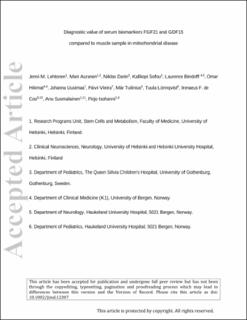Diagnostic value of serum biomarkers FGF21 and GDF15 compared to muscle sample in mitochondrial disease
Lehtonen, Jenni M.; Auranen, Mari; Darin, Niklas; Sofou, Kalliopi; Bindoff, Laurence; Hikmat, Omar; Uusimaa, Johanna; Vieira, Paivi; Tulinius, Már; Lönnqvist, Tuula; de Coo, Irenaeus F.; Suomalainen, Anu; Isohanni, Pirjo
Journal article, Peer reviewed
Accepted version
Permanent lenke
https://hdl.handle.net/11250/2739743Utgivelsesdato
2021Metadata
Vis full innførselSamlinger
- Department of Clinical Medicine [2065]
- Registrations from Cristin [9766]
Sammendrag
The aim of this study was to compare the value of serum biomarkers, fibroblast growth factor 21 (FGF21) and growth differentiation factor 15 (GDF15), with histological analysis of muscle in the diagnosis of mitochondrial disease. We collected 194 serum samples from patients with a suspected or known mitochondrial disease. Biomarkers were analyzed blinded using enzyme‐labeled immunosorbent assay. Clinical data were collected using a structured questionnaire. Only 39% of patients with genetically verified mitochondrial disease had mitochondrial pathology in their muscle histology. In contrast, biomarkers were elevated in 62% of patients with genetically verified mitochondrial disease. Those with both biomarkers elevated had a muscle manifesting disorder and a defect affecting mitochondrial DNA expression. If at least one of the biomarkers was induced and the patient had a myopathic disease, a mitochondrial DNA expression disease was the cause with 94% probability. Among patients with biomarker analysis and muscle biopsy taken <12 months apart, a mitochondrial disorder would have been identified in 70% with analysis of FGF21 and GDF15 compared to 50% of patients whom could have been identified with muscle biopsy alone. Muscle findings were nondiagnostic in 72% (children) and 45% (adults). Induction of FGF21 and GDF15 suggest a mitochondrial etiology as an underlying cause of a muscle manifesting disease. Normal biomarker values do not, however, rule out a mitochondrial disorder, especially if the disease does not manifest in muscle. We suggest that FGF21 and GDF15 together should be first‐line diagnostic investigations in mitochondrial disease complementing muscle biopsy.
